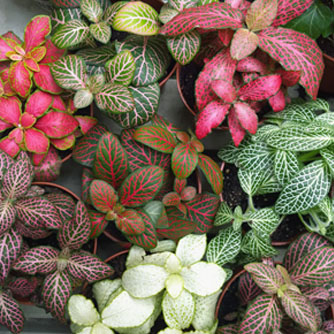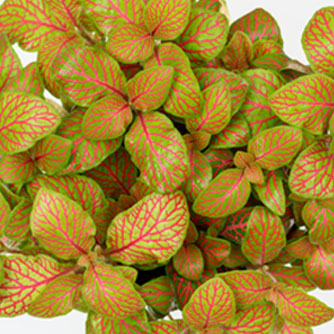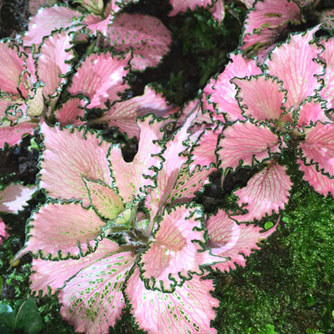Fittonia
BackFittonia are increasingly popular indoor plants thanks to their amazing foliage. Plants are available in a range of colours including white, pink, red and several shades of green with contrasting white, pink or red veins. The pattern this makes in the foliage is stunning and explains why they are often referred to as ‘nerve plants’.
Fittonia are quite compact little plants and look spectacular when several different varieties are grown together. They’re the ideal plant to add a real wow factor to your indoor collection!
How To Grow Fittonia
Fittonia originate from tropical forests in South America which gives you an indication of their preferred growing conditions. They love warmth and humidity!
Position them inside in a brightly lit spot but not in direct sunlight which can burn the foliage. The dimmer the position the less colourful the leaves may become. If your bathroom gets plenty of light this can be a good spot thanks to the high humidity levels.

Super colourful fittonia
Fittonia will only grow to only around 15cm tall but can spread up to 20cm wide if given enough room. A small pot 10cm in diameter is usually large enough to keep them happy. Ensure the pot has adequate drainage holes and use a good quality potting mix. When transplanting a fittonia into a new pot, water in with OCP eco-seaweed to help reduce transplant shock and encourage new roots to develop.
Fittonias will droop their foliage when they’re thirsty but it’s best not to let them get this dry. Instead always keep the potting mix slightly moist but not wet. Being from the humid tropics fittonias will appreciate their foliage being misted with water during very dry weather or when indoor air conditioning or heating creates a dry atmosphere. Alternatively a potted fittonia can also be sat on a saucer filled with water and a layer of pebbles. The water helps create a more humid environment around the plant and the pebbles elevate the pot so that it’s not sitting directly in water which might otherwise cause root rot.
You can also grow fittonia in a terrarium where the enclosed space will help keep humidity levels high. The potting mix will still need to be kept moist to keep the plant happy but don’t let water build up in the bottom of the terrarium or rotting can occur. if you tend to be a bit heavy handed with watering then place a layer of pebbles on the bottom of the terrarium, followed by a sprinkling of horticultural charcoal and then the potting mix. This will help reduce the risk of rot if you do accidentally over water.
In warm climates fittonia can be grown outside in a shaded position provided temperatures don’t drop below 15 degrees. They will need rich fertile soil and to be kept moist in order to thrive.

The eye-catching lime green and red veined fittonia
Fertilising and Maintenance of Fittonia
Fittonia are fairly undemanding little plants but if you want to get the most out of them then apply OCP eco-seaweed and OCP eco-aminogro every 2-4 weeks from spring to autumn. This will help promote healthy leaf growth.
To encourage compact and tidy growth stem tips can be trimmed off if necessary. Likewise if your plant gets too large for the pot or terrarium you can simply cut it back during the warmer months and new side shoots will appear soon after.
Propagating Fittonia
Stem cuttings will easily root in soil or water. Take 5-7cm long pieces, remove the lower leaves and insert into some potting mix. Keep moist and humid until you see new shoot developing. For the water method again remove the lower leaves and place in a glass of water. Wait until you see a strong roots develop and then potting into soil. Cuttings will strike faster during the warmer months.

Fittonia are well suited to being grown in small pots
Pests and Diseases of Fittonia
Fittonia are fairly tough plants but like most indoor plants there are a few things which can go wrong from time to time.
- Fungus gnats – if these pesky guys find your plant then drench the potting mix with OCP eco-neem to kill the juveniles and break the lifecycle.
- Sap suckers – Mealybugs, mites and even aphids can sometimes be problem. Spray plants thoroughly with OCP eco-neem and do a follow up spray several days later. Keep a close eye on your plant in case the pests return.
- Rotting – rotting of foliage or roots is a sign of poor drainage and waterlogging. While fittonia needs moist soil they also need air around their roots too so ease up on the watering (especially if growing in a terrarium which has no drainage holes).

The beautiful pink fittonia


